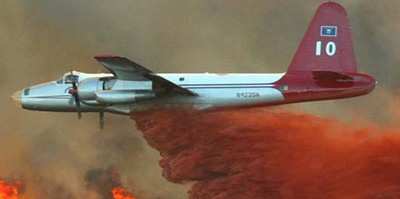Fri, Jun 15, 2012
Few Details Known About The Accident Involving A P2V-7 Aerial Tanker
While the NTSB has released its preliminary report for an accident in which an aerial tanker (similar aircraft pictured) involved in a firefighting operation in Utah earlier this month went down, investigators are apparently going to have a lot of work to do to determine the probable cause of the accident. The prelim describes the path of the accident flight, and indicates that the airplane was "substantially damaged" by the impact and post-crash fire ... but little more.

NTSB Identification: WPR12GA243
Nonscheduled 14 CFR Public Use
Accident occurred Sunday, June 03, 2012 in Modena, UT
Aircraft: LOCKHEED P2V-7, registration: N14447
Injuries: 2 Fatal.
This is preliminary information, subject to change, and may contain errors. Any errors in this report will be corrected when the final report has been completed.
On June 3, 2012, at 1347 mountain daylight time, a Lockheed P2V-7, N14447 (using call sign Tanker 11), collided with mountainous terrain while conducting firefighting operations 20 miles north of Modena, Utah. The airplane was operated by Neptune Aviation Services under contract with the US Forest Service as a public aerial firefighting flight. Both pilots were fatally injured. The airplane was substantially damaged by impact forces and a post crash fire. Visual meteorological conditions prevailed, and a company flight plan had been filed. The flight originated in Cedar City, Utah, at 1315.
While conducting its second retardant drop of the day, Tanker 11 followed behind the lead airplane into the drop zone. The drop zone was located in a shallow valley that was 0.4 miles wide and 350 feet deep. The lead airplane flew a shallow right-hand turn on to final, and dropped to an altitude of 150 feet above the valley floor over the intended drop area. While making the right turn on to final behind the lead plane, Tanker 11 impacted rising terrain that was about 700 feet left of the lead airplane's flight path.
More News
From 2023 (YouTube Version): Legacy of a Titan Robert (Bob) Anderson Hoover was a fighter pilot, test pilot, flight instructor, and air show superstar. More so, Bob Hoover was an i>[...]
Get The Latest in Aviation News NOW on Instagram Are you on Instagram yet? It's been around for a few years, quietly picking up traction mostly thanks to everybody's new obsession >[...]
Aero Linx: B-52H Stratofortress The B-52H Stratofortress is a long-range, heavy bomber that can perform a variety of missions. The bomber is capable of flying at high subsonic spee>[...]
Altimeter Setting The barometric pressure reading used to adjust a pressure altimeter for variations in existing atmospheric pressure or to the standard altimeter setting (29.92).>[...]
"Knowing that we play an active part in bettering people's lives is extremely rewarding. My team and I are very thankful for the opportunity to be here and to help in any way we ca>[...]
 Classic Aero-TV: Remembering Bob Hoover
Classic Aero-TV: Remembering Bob Hoover ANN FAQ: Follow Us On Instagram!
ANN FAQ: Follow Us On Instagram! ANN's Daily Aero-Linx (05.15.24)
ANN's Daily Aero-Linx (05.15.24) ANN's Daily Aero-Term (05.15.24):Altimeter Setting
ANN's Daily Aero-Term (05.15.24):Altimeter Setting Aero-News: Quote of the Day (05.16.24)
Aero-News: Quote of the Day (05.16.24)



